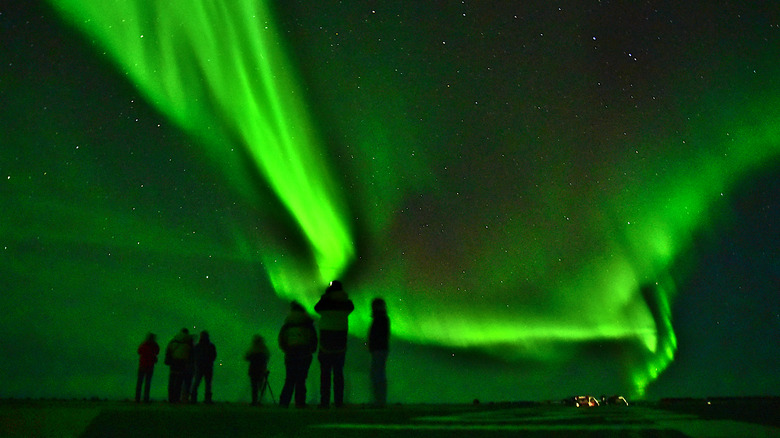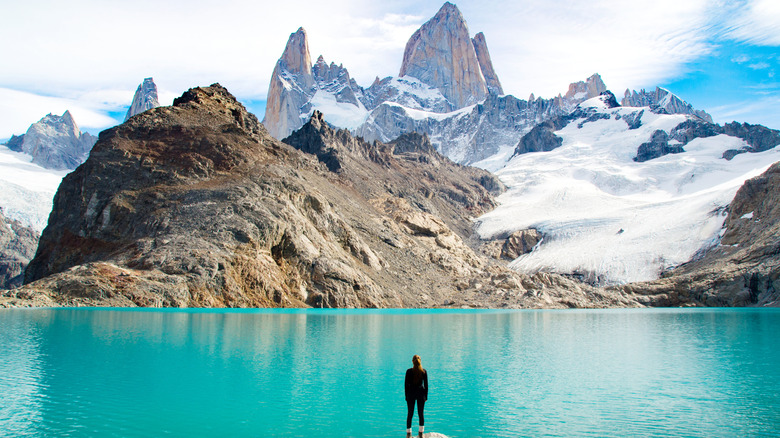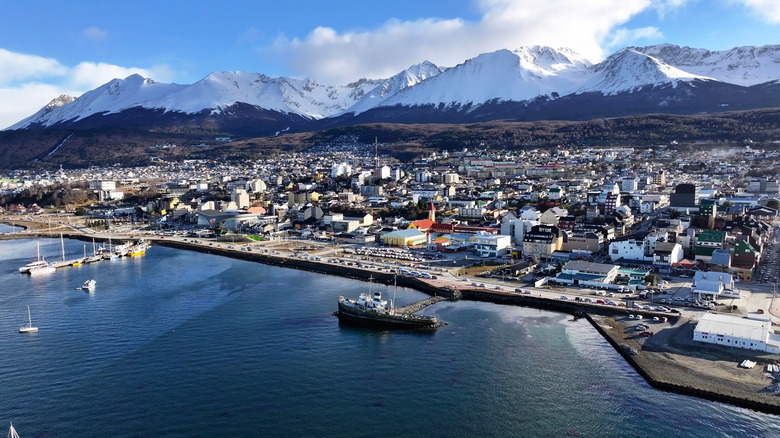This Breathtaking Destination Offers One Of The Best Views Of The Wildly Overlooked Southern Lights
The northern lights have long stolen the celestial spotlight. But the aurora australis, or the wildly overlooked southern lights, are just as captivating. Essentially, they're the same atmospheric phenomenon occurring in different parts of the world, but because the northern lights are much easier to access, the southern lights receive far less attention. Part of what makes them so spectacular is that spotting them requires a more adventurous journey. Enter: Patagonia — a wild expanse of glaciers, forests, and mountains, notoriously known for being tough to get to — but worth the journey.
Patagonia sits between Argentina and Chile, covering a large portion of the southern tip of the South American continent. It's raw, undeveloped, and cold — three ideal conditions for viewing the southern lights. The aurora is at its brightest in the southern hemisphere's winter between April to August, when the skies are at their darkest and humidity is low.
Patagonia feels like the edge of the world. And in many ways, it is. Its remoteness and difficulty to access is legendary. Combine this with endless glacial lakes, remote fjords, and towering granite mountains, and it's no surprise this is one of the least populated places on Earth. Getting to Patagonia isn't as simple as catching a flight and ordering an Uber, and this is all part of its appeal. A common entry point is through a small town called Ushuaia in Argentina, the capital city of South America's largest island. Aptly nicknamed 'the end of the world,' Ushuaia is a small port city where many cruises depart for the most remote corners of Antarctica. It's set in Argentina's least unpopulated province of Tierra del Fuego – known for its high Andes Mountain range which are at just the right latitude and altitude for aurora sightings.
Patagonia is a hub of outdoor adventure and adrenaline-feuled activities
Covering a massive area of more than 300 thousand square miles from the Atlantic to the Pacific Ocean, it's hard to put into words how many unique geographies exist in this landscape. It's a haven for all sorts of outdoor adventures, from horseback riding to kayaking to hiking to rock and ice climbing. No doubt the most common Patagonian activity is trekking and hiking. The region's hallmark adventure is the 55-mile W Trek and longer O Circuits that run through the Chilean Torres del Paine National Park, one of 17 national parks in the region. This is where you'll find the Cuernos del Paine, dubbed Patagonia's Half Dome for being so frequently photographed. The quickest way to get to this part of Patagonia is through El Calafate or Punta Arenas, two nearby cities with regional airports.
Another iconic Patagonia adventure is hiking through Argentina's Los Glaciares National Park. Its crowning glory is the Fitz Roy Massif, an enormous mountain with jagged peaks perfect for advanced rock climbers. The most common route is the Lagune de los Tres and Laguna Torre trail. Even for day hikes, exploring with a guide is always recommended.
When you can't fathom another day on your feet, there's plenty to experience around Ushuaia and El Calafete, two of Patagonia's main cities. Scenic heli-tours are an exciting (although pricey) way to view the landscape from a unique perspective. There's even a ranch just outside of Ushuaia. Established in 1886, Estancia Harberton, the first Fuegian ranch in the area, is an interesting place to learn about Patagonia. From October to March, visitors can stay on the farm, or grab a traditional Patagonian meal in the place where Ushuaia's history all began.
Everything you need to know about visiting Patagonia
Ushuaia is the southernmost city to use as a base for a Patagonian adventure. During winter — June – August — it experiences up to 17 hours of darkness, increasing your chances of spotting the southern lights if they do make an appearance. The town's Malvinas Argentinas International Airport welcomes regional airlines like Aerolineas Argentinas and JetSMART, directly connecting Patagonia with South America. Most flights arrive from Argentina's capital of Buenos Aires, an easy three hour and forty minute flight away.
The town is a tourist hub, so it has plenty of places to stay ranging from five-star hotels to remote cabins. El Calafate is another Patagonian hub, located much further north in Argentina's Santa Cruz Province and commonly used as a base for exploring the Los Glaciares National Park. Comandante Armando Tola International Airport, just east of the city, welcomes flights from both Buenos Aires and Ushuaia. From the airport, taxis and buses can transfer you into the city, although we recommend organizing a private or group tour to guide your adventures.
Whether visiting mid-winter to spot the southern lights or for a summer hiking adventure December to February, you can expect the weather in Patagonia to be cool, unpredictable, and often extreme. Summer in particular is Patagonia's windy season. Packing requires a bit of forethought, particularly dependent on what you plan to do on your trip. Generally speaking, it's always advised to pack plenty of layers, comfortable hiking and walking shoes, and all your regular and emergency medications. Thermal underwear, water- and wind-proof outerwear, and fleece jackets are a good idea for layering. Credit cards may not be accepted everywhere, so having cash on hand, both Chilean and Argentinean Pesos, is necessary.


